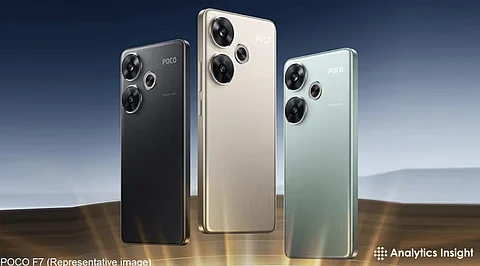

The smartphone market witnesses a fierce fight between the Xiaomi 15 Ultra and Poco F7 Ultra, both being Xiaomi ecosystem phones fighting to be the best. Although the Poco F7 Ultra was launched in March 2025 with amazing benchmark scores, the first-launched Xiaomi 15 Ultra provides best-in-class features.
This article delves into the technicalities, design approaches, and performance figures of both to find out which flagship takes the lead in this no-holds-barred battle.
The Snapdragon 8 Elite chipset, at the core of both handsets, is a chipset that has been touted for its revolutionary performance. The VisionBoost D7, which is a 12nm dedicated graphics processing unit, is combined with this in the Poco F7 Ultra to achieve an AnTuTu v10 benchmark score of 2,843,461 in a test configuration. This surpasses the Xiaomi 15 Ultra's record score of 2,700,000, as noted during initial tests.
The VisionBoost D7 boosts gaming smoothness, at least reaching 120 FPS in Genshin Impact in 2K, something the Xiaomi 15 Ultra cannot manage without comparable graphics enhancement. Practical usage in the real world may modulate these test results, where heat throttling and software optimization will contribute more to performance in real-world usage than pure figures.
The VisionBoost D7, a 12nm dedicated graphics processing unit, is paired with this in the Poco F7 Ultra to achieve an AnTuTu v10 benchmark score of 2,843,461 in a lab environment. This is above the Xiaomi 15 Ultra's benchmark of 2,700,000, as reported in early tests.
Screen technology betrays different approaches. The Poco F7 Ultra boasts a 6.67-inch 2K AMOLED screen with a 120Hz refresh rate, supported by VisionBoost D7's processing capabilities. The brightness is capped at 3,200 nits, providing sharp visuals for gaming and multimedia. The Xiaomi 15 Ultra, on the other hand, goes for a slightly bigger 6.73-inch LTPO AMOLED screen, also 2K in resolution, but features a dynamic 1-120Hz refresh rate and a 3,500-nit peak brightness. Dolby Vision and HDR10+ support enhance its cinematic edge.
Camera features and image quality set these top phones apart. The Xiaomi 15 Ultra has a Leica-designed quad-camera system. It has a 200MP main sensor with optical image stabilization, a 50MP ultra-wide-angle camera, a 50MP periscope telephoto camera (5x telephoto), and a 12MP macro camera. This arrangement is top-notch in terms of versatility, delivering crisp, colourful images under various lighting conditions.
Meanwhile, the Poco F7 Ultra fields a 50MP Sony IMX906 main sensor with OIS, an 8MP ultra-wide, and a 2MP macro, solid but less ambitious. Social media posts on X praise Xiaomi’s zoom and low-light prowess, while Poco’s simpler array suits casual users. Leica’s tuning gives Xiaomi a clear lead in imaging sophistication.
End endurance hinges on battery design. The Poco F7 Ultra houses a 6,000mAh cell with 90W HyperCharge, fully juicing up in roughly 35 minutes. This battery offers longer gaming time, but extreme modes will suck it dry in no time. The Xiaomi 15 Ultra features a 5,500mAh battery, with 120W wired and 50W wireless charging support, something that Poco doesn't have.
Xiaomi's power-saving optimizations from HyperOS 2.0 help the battery last longer even with its lower capacity. Charging flexibility gives Xiaomi the upper hand, albeit Poco's bigger battery beckons power-consumption-demanding activities.
Design philosophies are marginally different. The Poco F7 Ultra has a bold yellow-black two-tone, 212g, IP68-rated build with panache and solidity. The 225g Xiaomi 15 Ultra has a sophisticated glass-metal build, also IP68-rated, with premium class oozing from it.
Both use HyperOS 2.0 over Android 15 with smooth navigation and tweakability. Poco's Wild Boost 3.0 tweaks are all about gaming responsiveness, while Xiaomi balances performance with AI battery saving. Software parity means neither falls behind, but Poco's gaming focus is contrasted with Xiaomi's all-around polish.
Price dictates their appeal. The Poco F7 Ultra, circa ₹59,990 abroad, is for budget-conscious enthusiasts who desire purist power. The Xiaomi 15 Ultra, at about ₹89,990, is for premium buyers who value camera performance and build. Benchmarks favour Poco's value for money, 2.8 million AnTuTu points for less, but Xiaomi's broader feature set justifies its premium. Market acceptance, according to X chatter, is in Poco's favour in gaming but Xiaomi in photography.
Determining the outperformer hinges on priorities. The Poco F7 Ultra has a Snapdragon 8 Elite and VisionBoost D7 that are the best for tests and gaming, offering great value. The Xiaomi 15 Ultra has better cameras, a brighter screen, and flexible charging, making it a more advanced flagship. Poco is all about pure power, but Xiaomi focuses on being adaptable for overall quality. Both phones are great in their own way, so it comes down to what you like more: speed or style.
